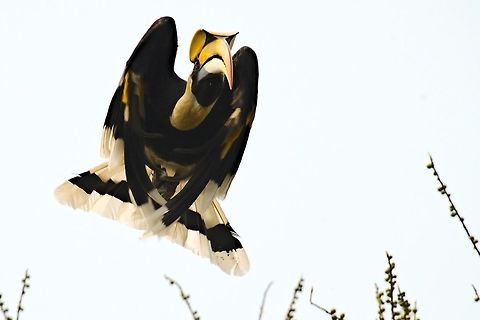
Appearance
The great hornbill is a large bird, 95–130 cm long, with a 152 cm wingspan and a weight of 2.15–4 kg . It is the heaviest, but not the longest, Asian hornbill. Females are smaller than males and have bluish-white instead of red eyes, although the orbital skin is pinkish. Like other hornbills, they have prominent "eyelashes".The most prominent feature of the hornbill is the bright yellow and black casque on top of its massive bill. The casque appears U-shaped when viewed from the front, and the top is concave, with two ridges along the sides that form points in the front, whence the Latin species epithet ''bicornis'' . The back of the casque is reddish in females, while the underside of the front and back of the casque is black in males.
The casque is hollow and serves no known purpose, although it is believed to be the result of sexual selection. Male hornbills have been known to indulge in aerial casque butting, with birds striking each other in flight. The male spreads the preen gland secretion, which is yellow, onto the primary feathers and bill to give them the bright yellow colour. The commissure of the beak is black and has a serrated edge which becomes worn with age.
The wing beats are heavy and the sound produced by birds in flight can be heard from a distance. This sound has been likened to the puffing of a steam locomotive starting up; or a helocopter's chopping whir. The flight involves stiff flaps followed by glides with the fingers splayed and upcurled. They sometimes fly at great height over forests.
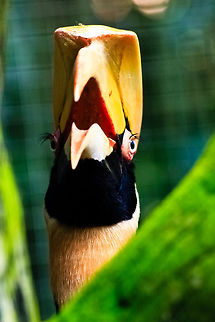
Distribution
Great hornbills are found in the forests of India, Bhutan, Nepal, Mainland Southeast Asia, Indonesian Island of Sumatra and North eastern region of India. The distribution of the species is fragmented over its range in the Indian subcontinent and Southeast Asia. In the subcontinent they are found in a few forest areas in the Western Ghats and in the forests along the Himalayas. Their distribution extends into Thailand, Burma, Malaya, and Sumatra. A small feral population is found in Singapore. Their habitat is dense old growth forests in hilly regions. They appear to be dependent on large stretches of forest, unlike many of the smaller hornbills.In Thailand the home range of males was found to be about 3.7 km2 during the breeding season and about 14.7 km2 during the non-breeding season.
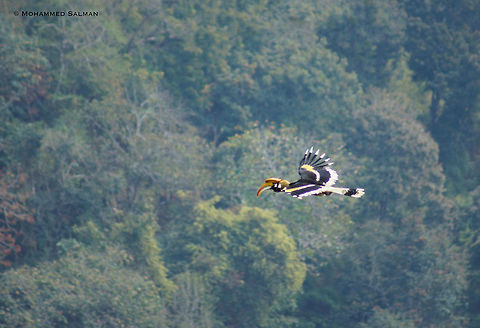
Status
Due to habitat loss and hunting in some areas, the great hornbill is evaluated as near threatened on the IUCN Red List of Threatened Species. It is listed in Appendix I of CITES. Declines in population have been noted in many areas such as Cambodia. Molecular approaches to the study of their population diversity have been attempted.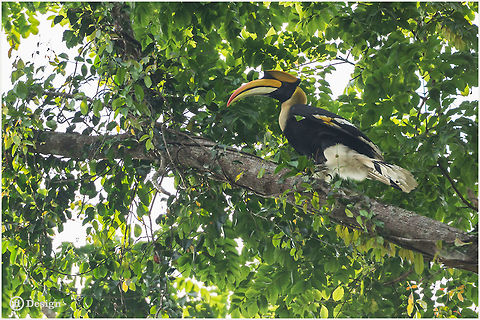
Habitat
Great hornbills are found in the forests of India, Bhutan, Nepal, Mainland Southeast Asia, Indonesian Island of Sumatra and North eastern region of India. The distribution of the species is fragmented over its range in the Indian subcontinent and Southeast Asia. In the subcontinent they are found in a few forest areas in the Western Ghats and in the forests along the Himalayas. Their distribution extends into Thailand, Burma, Malaya, and Sumatra. A small feral population is found in Singapore. Their habitat is dense old growth forests in hilly regions. They appear to be dependent on large stretches of forest, unlike many of the smaller hornbills.In Thailand the home range of males was found to be about 3.7 km2 during the breeding season and about 14.7 km2 during the non-breeding season.
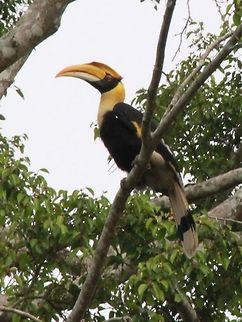
Reproduction
During the breeding season great hornbills become very vocal. They make loud duets, beginning with a loud "kok" given about once a second by the male, to which the female joins in. The pair then calls in unison, turning into a rapid mixture of roars and barks. They prefer mature forests for nesting. Large, tall and old trees, particularly emergents that rise above the canopy, seem to be preferred for nesting. They form monogamous pair bonds and live in small groups of 2-40 individuals. Group courtship displays involving up to 20 birds have been observed.The female hornbill builds a nest in the hollow of a large tree trunk, sealing the opening with a plaster made up mainly of feces. She remains imprisoned there, relying on the male to bring her food, until the chicks are half developed. During this period the female undergoes a complete moult. The young chicks have no feathers and appear very plump. The mother is fed by her mate through a slit in the seal. The clutch consists of one or two eggs, which she incubates for 38–40 days. The female voids feces through the nest slit, as do the chicks from the age of two weeks. Once the female emerges from the nest, the chicks seal it again.
The young birds have no trace of a casque. After the second year the front extremity separates from the culmen, and in the third year it becomes a transverse crescent with the two edges growing outwards and upwards, while the anterior widens to the width of the rear end. Full development takes five years.
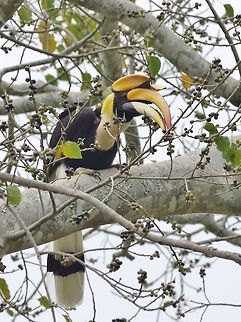
Food
Great hornbills are usually seen in small parties, with larger groups sometimes aggregating at fruit trees. A congregation of 150 to 200 birds has been recorded in southeastern Bhutan. In the wild, the great hornbill's diet consists mainly of fruit. Figs are particularly important as a food source. ''Vitex altissima'' has been noted as another important food source. Great hornbills also forage on lipid-rich fruits of the Lauraceae and Myristicaceae families such as ''Persea'', ''Alseodaphne'' and ''Myristica''. They obtain the water that they need entirely from their diet of fruits. They are important dispersers of many forest tree species. They will also eat small mammals, birds, small reptiles and insects. Lion-tailed macaques have been seen to forage alongside these hornbills.They forage along branches, moving along by hopping, looking for insects, nestling birds and small lizards, tearing up bark and examining them. Prey are caught, tossed in the air and swallowed. A rare squirrel, the Travancore flying squirrel has been eaten, and Indian scops owl , jungle owlet and Sri Lanka green pigeon have been taken as prey in the Western Ghats.
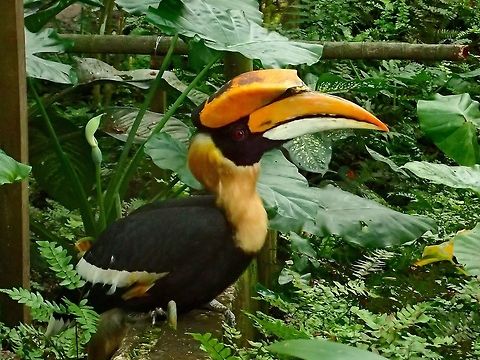
Defense
Roost sites are used regularly and birds arrive punctually at sunset from long distances, following the same routes each day. Several tall trees in the vicinity may be used, the birds choosing the highest branches with little foliage. They jockey for position until late at dusk. When sleeping they draw their neck back and the bill is held upwards at an angle.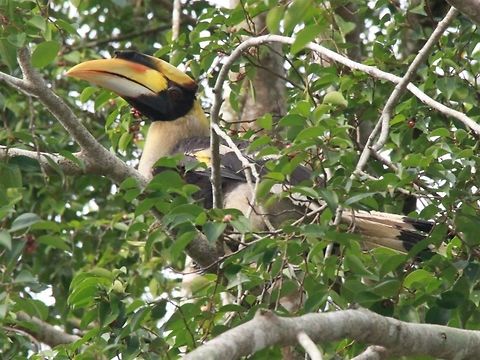
Cultural
Tribal peoples threaten the great Indian hornbill by hunting it for its various parts. The beaks and head are used in charms and the flesh is believed to be medicinal. Young birds are considered a delicacy. Tribesmen in parts of northeastern India and Borneo use the feathers for head-dresses, and the skulls are often worn as decorations. The Sema Nagas consider the flesh unfit for eating, believing that it produces sores on their feet, as in the bird. When dancing with the feathers of the hornbill, they avoid eating vegetables, as doing so is also believed to produce the same sores on the feet. Among the Zomi, a festival without a hornbill feather is incomplete. Conservation programmes have attempted to provide tribes with feathers from captive hornbills and ceramic casques to substitute for natural ones.The great hornbill is called ''homrai'' in Nepal and ''banrao'', both meaning "king of the forest". It is called "Vezhaambal" in Malayalam.
References:
Some text fragments are auto parsed from Wikipedia.